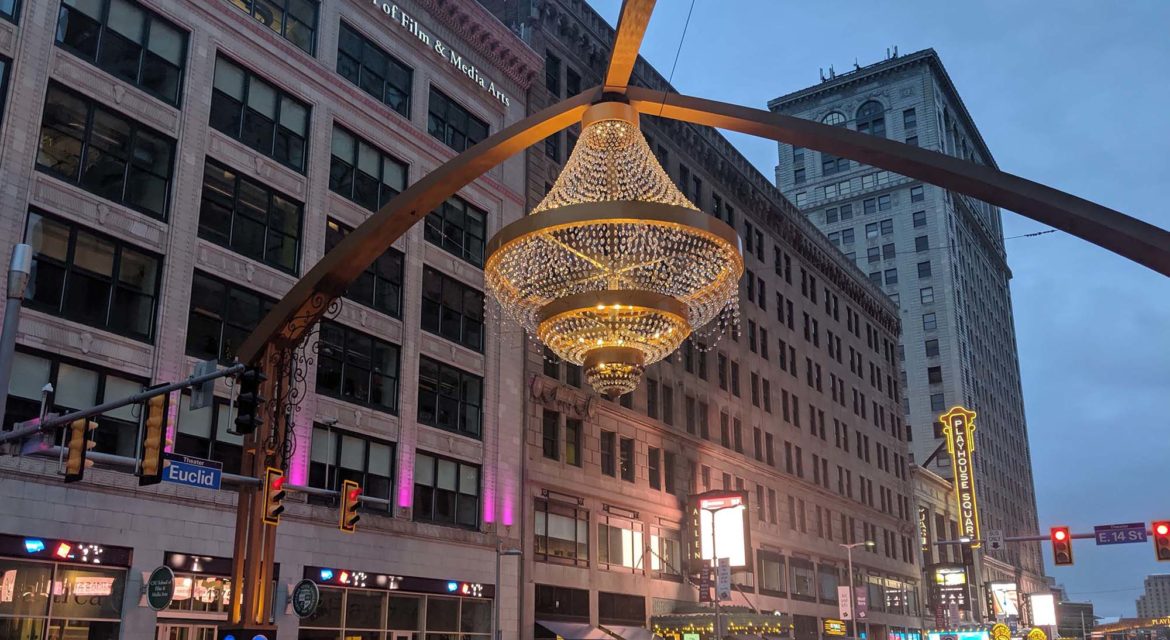 Squares of all types have come to define an area, but few have enabled the kind of redefinition like Playhouse Square has for Cleveland, Ohio. As one of the largest performing arts centers in the United States, Playhouse Square has been able to create an identity for the area that has enabled a critical rebirth that has spread throughout the downtown area. Centered on theatres that were brought back to life as well as the creation of an icon, Playhouse Square showcases what’s possible when a space becomes a destination.
Squares of all types have come to define an area, but few have enabled the kind of redefinition like Playhouse Square has for Cleveland, Ohio. As one of the largest performing arts centers in the United States, Playhouse Square has been able to create an identity for the area that has enabled a critical rebirth that has spread throughout the downtown area. Centered on theatres that were brought back to life as well as the creation of an icon, Playhouse Square showcases what’s possible when a space becomes a destination.

The Cleveland Theater District
 Not long after World War I, a Cleveland developer envisioned a row of theaters in the downtown area to create a theatre district. That led to the creation of the Ohio and State Theatres, which opened in 1921. Later that year, the Hanna Theatre and the Allen Theatres were opened, followed by the Palace Theatre in 1922. The Palace Theatre became the regional flagship of a chain of vaudeville theaters and represented the high point of development in the area.
Not long after World War I, a Cleveland developer envisioned a row of theaters in the downtown area to create a theatre district. That led to the creation of the Ohio and State Theatres, which opened in 1921. Later that year, the Hanna Theatre and the Allen Theatres were opened, followed by the Palace Theatre in 1922. The Palace Theatre became the regional flagship of a chain of vaudeville theaters and represented the high point of development in the area.
For multiple decades all of the venues presented a variety of serious theater, vaudeville shows and silent movies but the rise of television and movie theatres greatly impacted attendance. All of the theatres except for the Hanna Theatre had closed by 1969, although an effort to restore them began almost immediately. Referred to as the “world’s largest theater restoration project,” planners formed a group known as the Playhouse Square Association and launched a vigorous grass-roots campaign to save the theaters. Those efforts saw Playhouse Square being added to the National Register of Historic Places in 1978 along with the reopening of the original theatres, which began in 1982.
Today, the area contains 10 performance spaces, including five theaters restored to their original 1920s appearance, along with a 20 ft. tall chandelier made with 4,200 crystals, hanging 44 ft. above the street was installed in Playhouse Square in 2014. All of these elements have enabled activity that has made a major impact on the culture and economy of Cleveland.

Events, Experiences and Economic Impact
 Throughout the year, Playhouse Square hosts more than 1,000 events that includes concerts, comedy, dance performances and children’s programming to packed houses. Outside of these theatres, the GE Chandelier has become a centerpiece for events such as the Tri-C JazzFest and weekly summer farmers markets. Sponsored by GE, the piece is also a backdrop for countless Instagram and Facebook posts.
Throughout the year, Playhouse Square hosts more than 1,000 events that includes concerts, comedy, dance performances and children’s programming to packed houses. Outside of these theatres, the GE Chandelier has become a centerpiece for events such as the Tri-C JazzFest and weekly summer farmers markets. Sponsored by GE, the piece is also a backdrop for countless Instagram and Facebook posts.
All of that activity has enabled a notable economic impact on the city. Playhouse Square draws more than 1 million people annually to its 11 performance spaces while contributing in excess of $43 million in local economic impact every year exclusively from its performing arts activity. Outside of the theatres themselves, Star Plaza features a stage, seating walls and planting beds, and an outdoor fire pit. It also houses the Dynomite hamburger pavilion operated by a celebrated Cleveland chef. However, that activity and benefits it has created extend beyond Playhouse Square.
Positive changes throughout the downtown area are rooted in the energy at Playhouse Square which has created a notable economic impact. Entire blocks located within the vicinity of Playhouse Square have been transformed into dining, entertainment and nightlife destinations. Efforts to turn the district into a viable residential community are the result of the activity that Playhouse Square has created.
What was once to become a parking lot has instead become a hub for entertainment, business and housing for the benefit of the entire city of Cleveland. The creation of an “instant icon” further spurred the interest in the area, all of which showcases what it can mean for a space to become a monument and enable an identity that an entire community can embrace.

A Destination for Cleveland
 Featured in countless maps and other guides to the city, Playhouse Square has become a tourist destination, economic development engine, entertainment producer, district real estate developer, and national leader in arts education. In doing so, it showcases what it can mean for an area to become a destination that attracts audiences from across a city and region.
Featured in countless maps and other guides to the city, Playhouse Square has become a tourist destination, economic development engine, entertainment producer, district real estate developer, and national leader in arts education. In doing so, it showcases what it can mean for an area to become a destination that attracts audiences from across a city and region.

